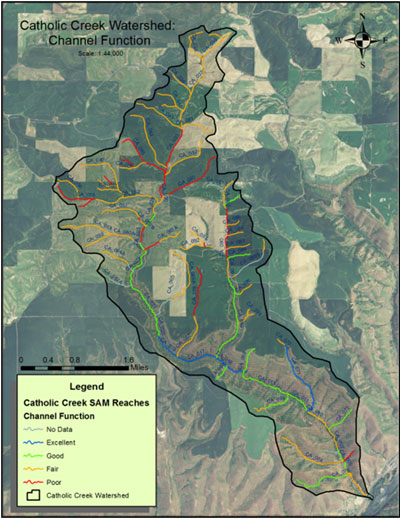One of the five objectives identified in the Catholic Creek Watershed Management Plan is to increase habitat diversity.
Objective Description:
Improve aquatic habitat diversity and complexity to levels consistent with objectives in the subbasin plan, with particular emphasis on recovery of anadromous stocks. Aquatic habitat condition (including diversity and/or complexity components) is limiting all focal species. Improvement in habitat productivity is considered critical to attainment of goals for both anadromous and resident species. Address priority problems with protection and restoration activities designed to promote development of more complex and diverse habitats through improved watershed condition and function. Desired outcomes include additions of large woody debris, stream channel reconstruction, increased side channels, increased pool quality/quantity, floodplain reconstruction, protecting and restoring wetland, and improved hydrologic functions. Benchmarks are noted in the deliverable descriptions for projects associated with this objective.
Deliverables:
In order to meet this objective two deliverables or treatments are identified:
Deliverable 1 – Remove and/or Retrofit Barriers
Priorities outlined in the Catholic Creek Watershed Management Plan will guide restoration efforts in targeting barriers to fish movement. Natural and man-made barriers that do not meet the management criteria of allowing upstream and downstream fish passage at all flows are identified for treatment.
One natural barrier was identified as a partial barrier during certain flow levels. Seven man-made barriers exist upstream of this site and are culverts.
Deliverable 2 – Restore Floodplain Access and Reconnect Channels
Priorities outlined in the Catholic Creek Watershed Management Plan will guide restoration efforts targeting upland areas where floodplain access is not meeting management criteria. Management criteria are based on the NOAA Matrix of Pathways and Indicators (NOAA, 1996) for channel condition and dynamics. These indicators include width to depth ratios <10, streambank conditions are >90% stable, with on average, less than 10% of banks actively eroding, and overbank flows occur on a 1.5 – 2 year event.
Floodplain access areas are identified as those areas designated as poor or fair in the Catholic Creek Stream inventory and assessment for channel condition (shown as red and orange lines in figure 1).
Treatments include removal of berms, dikes, contouring to allow access to floodplain, and road relocation.
Figure 1. Channel condition treatment areas.
